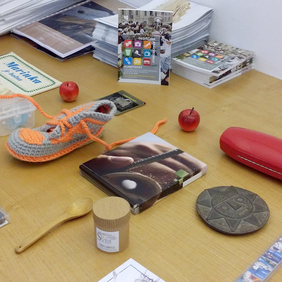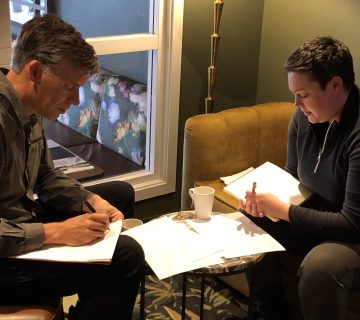Besides being a UNESCO World Heritage site, due to the extraordinary industrial heritage of its mercury mine, Idrija is also a place of extraordinary geological heritage and is one of two Slovenian geoparks. The area of the Geopark Idrija has an extremely diverse morphology, featuring deep and narrow ravines and gorges, as well as vast, high-lying, karstified plateaus, which is due to its position at the meeting point of the alpine and karst worlds.
The Idrija Tourism Board, UNESCO Global Geopark Idrija, is the leading partner of the Danube GeoTour Project. The main objective of the project is to work on sustainable tourism development in eight geoparks in the Danube region. One of the results of the project is a brand new visitor centre that opened in October 2019. Interpretation in the visitor centre is also how our Slovenian IE members came in touch with the tourism organisation in Idrija, which runs geopark activities.
They supported our team in the organisation of a promotional event, ‘Experiencing heritage’, where Slovene IE trainers ran two workshops. In the first workshop they presented the Certified Interpretive Writer (CIW) course and in the second workshop they presented the IE training programme and did some exercises that reflect IE training philosophy and methodology.
Some of the 40 participants attended both workshops, others took the opportunity to look around (the then not officially opened) visitor centre of the Geopark Idrija. There are not many opportunities for those who work in heritage and tourism to see the background of such a big project and talk about the execution of the activities with the project manager and coordinator.
The afternoon session was reserved for six presentations that emphasised planning and the tools of interpretation.
Our hosts from the tourism organisation presented how complex a collaboration it was to plan and execute a new visitor centre. Combining experts from geology, geography, botany, ethnology and interpretation.
A presentation from the second Slovenian geopark focused on pedagogical programmes within Geopark Karavanke. They emphasised that they do not have the resources to present geology to children from the wider region, so they have focused on teachers.
A family theatre group, Kolenc, from the geographical centre of Slovenia, presented part of their performance, which is based on interpretation of Slovene national symbols.
One of the partners in project Kras’n Krš from the Slovenian Academy of Science and Art presented on how they decided to reinforce the experience of karst heritage with developing a quiz that challenges visitors about their experience.
A ranger from Škocijan caves, another Slovenian UNESCO site, presented how have they tackled the issue of accessible heritage. They planned an exhibition about cave explorers in a way that is accessible to all visitors.
The last presenters came from the University of Primorska. The Department of Archaeology and Heritage manages an archaeological site by the sea, which is a great way for students to plan and do the interpretation on site and get practical experience during their studies.
This IE event was open to the general public but it was nice to see that the audience – composed of approximately half of IE members and half of people who are interested in interpretation – was joined in the same event talking about how to implement and improve heritage interpretation in Slovenia.
Janja Sivec is IE’s Country Coordinator Slovenia. You can reach her and other Slovene IE members through her at: janja.sivec@interpret-europe.net .
To cite this article:
Sivec, Janja(2019) ‘IE Slovenian members organise an EHD event’. In Interpret Europe Newsletter 4-2019, 20.
Available online: www.interpret-europe.net/fileadmin/Documents/publications/Newsletters/ie-newsletter_2019-4_winter.pdf




